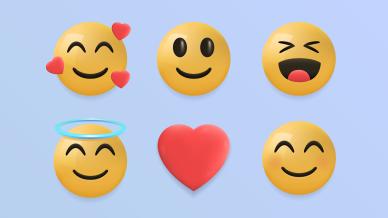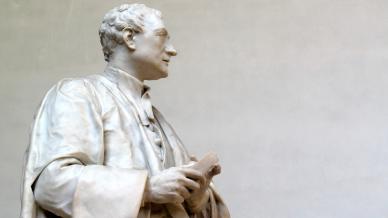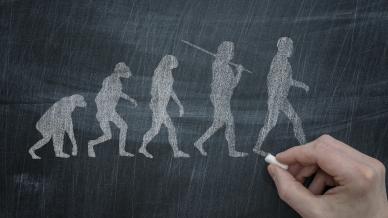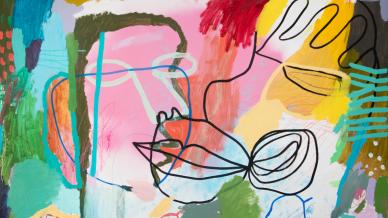On our International Literacy Day member lecture, WEA tutor and linguistics expert Janet Wilson explained how the laugh-out-loud and thumbs-up symbols we use in text messaging and WhatsApp conversations are much less modern than we might think…
Writing is a method of representing language in visual or tactile form, according to the website Omniglot.com. I rather like that definition for its simplicity. We may think of writing as an prehistoric tool, but it’s really a recent development in the history of civilisation.
While Ice Age communities may have used rudimentary symbols to communicate (including what looked like an early form of the #hashtag), the first writing systems emerged a mere 5,500 years ago. Before that, stories were passed down orally, from one generation to the next.
What caused humans to take up an implement and record their words for others to read? Nobody today knows for sure, but the most likely explanation is the creation of urban dwellings, which necessitated a permanent way of disseminating business transactions, laws and administration. The first known examples of literature and poetry were dated to a few thousand years later. Counting came before creativity.
Interestingly, writing appeared to start in entirely separate civilisations, around the same time, and always in response to the growth of larger settlements. Case closed?
Write like an Egyptian
The Ancient Egyptians weren’t the first to write, but their famous hieroglyphics took written communication to new levels of complexity. They used both pictographs (a picture of a tree to represent a tree) and also ideographs (a picture of a man leaning against a tree to represent a ‘taking a rest’).
With the passing of time, the arrival of alphabetisation, paper and then printing made writing closer to what we know today in the West. One of my favourite trivia facts is that the dual meaning of the word ‘spell’ comes from the same root. After all, what else is writing but a form of magic, whereby stories mystically appear from scribbles on a page?
The invention of the printing press in 1456 was a particular gamechanger, allowing the mass production of books, which led to a rapid spread in new ideas. People could now make a living as a writer and visit public libraries. Of course, some of these written words sparked massive, terrible wars and long-lasting bitterness. But many others led to great feats of beauty and technology that advanced society and brought people together.
The Internet was one such technology that has transformed the way we communicate. Mobile phones and social media may have their critics, but there’s no denying that they have revolutionised the art of conversation. We have seen the evolution of a whole new language – text speak and emoji – take place at warp speed. It’s remarkable to think that text messaging is only 30 years old. And the first emoji didn’t arrive on our screens until 2011. By 2015, 90% of the world’s online population were using them regularly.
Why so popular? Partly because they are fun and colourful. Emojis are also very useful for giving nuance to a short statement. “Rishi Sunak is now Prime Minister” has a very different emphasis if followed by either ![]() ,
, ![]() ,
, ![]() ,
, ![]() , or
, or ![]() .
.
Of course, the concept of using symbols is not that new. Just like the Egyptians, we use pictograms (the ![]() is shining) and ideograms (it’s going to be
is shining) and ideograms (it’s going to be ![]() today). We have come full circle. Although, as linguistics professor Vyv Evans recently proved in her study of emoji, our modern-day smileys have left the Egyptians in their dust.
today). We have come full circle. Although, as linguistics professor Vyv Evans recently proved in her study of emoji, our modern-day smileys have left the Egyptians in their dust.
"Emoji is the fastest growing form of language ever, based on its incredible adoption rate and speed of evolution,” she found. “As a visual language it has already far eclipsed hieroglyphics, its ancient Egyptian precursor which took centuries to develop."
Generational gap
There is a huge amount of depth in emoji, such as the ability to choose the appearance of a character to reflect different race or ethnicity, which can be used to show pride, inclusivity and, let’s be honest, bigotry too. It’s rather heartening that the LOL ![]() emoji is the world’s most popular, although it can be misinterpreted as crying with sadness, which defeats the purpose somewhat.
emoji is the world’s most popular, although it can be misinterpreted as crying with sadness, which defeats the purpose somewhat.
Indeed, many people over 40 get confused by emoji and lack confidence when using them. Meanwhile, a recent Gen-Z study showed that only ‘old’ people use the most common emoji such as ![]() ,
, ![]() , or
, or ![]() . Some young people see the
. Some young people see the ![]() emoji as hostile rather than encouraging. In a recent study conducted by Talk Talk Mobile, 72% of 18–25-year-olds admitted they found it easier to express their feelings through emoji rather than text.
emoji as hostile rather than encouraging. In a recent study conducted by Talk Talk Mobile, 72% of 18–25-year-olds admitted they found it easier to express their feelings through emoji rather than text.
The good news is that our reading brain circuitry is plastic and will adapt to the characters of the texts we read, whether on a screen or paper page. In fact, these different media will help maximise our cognitive potential by exercising different neural networks. It looks like the story of the written word still has a few more chapters left to write.
















